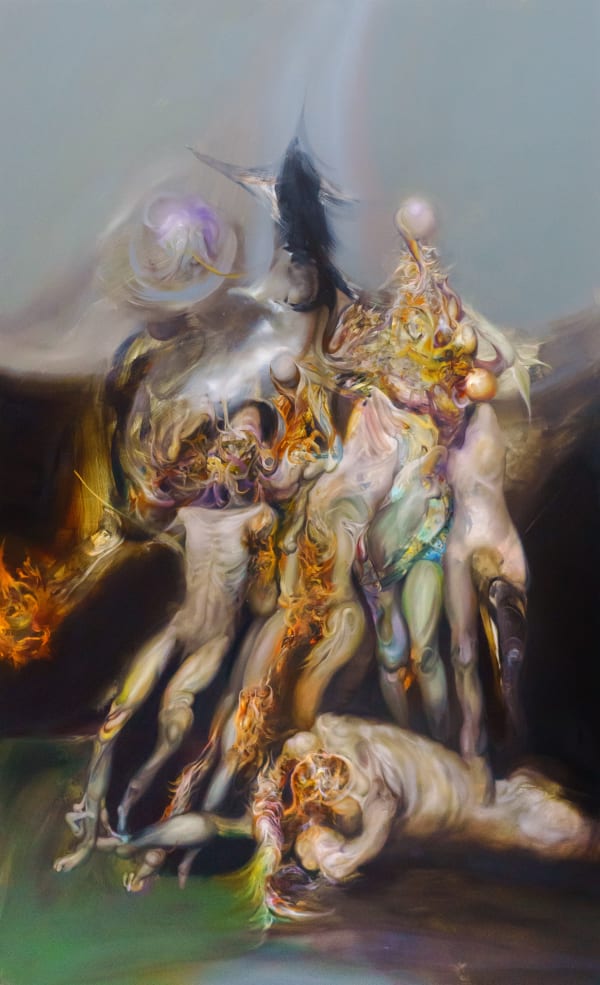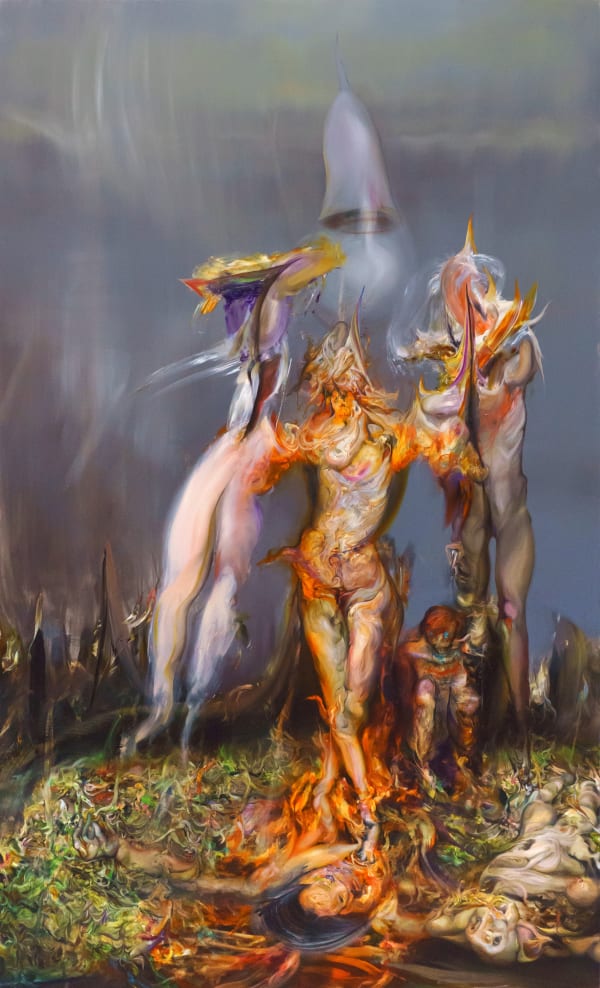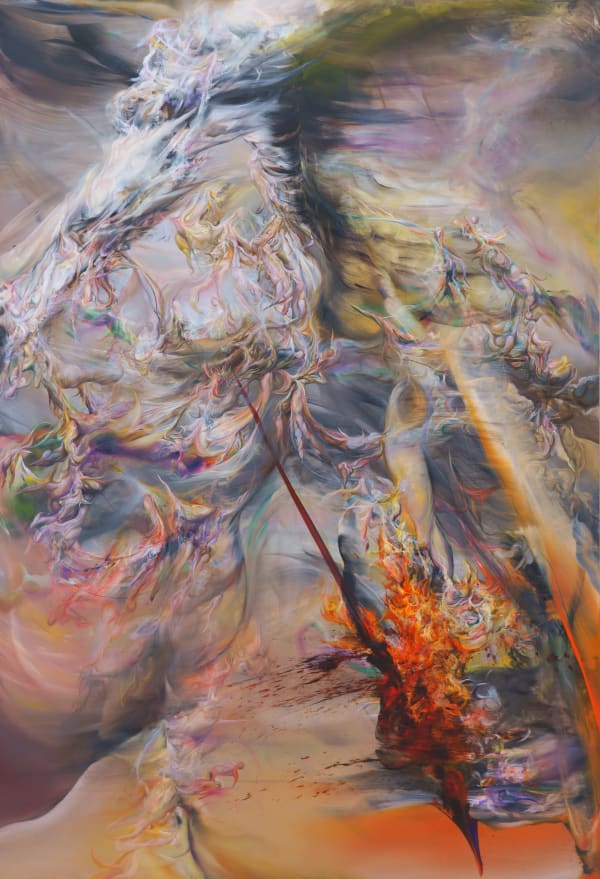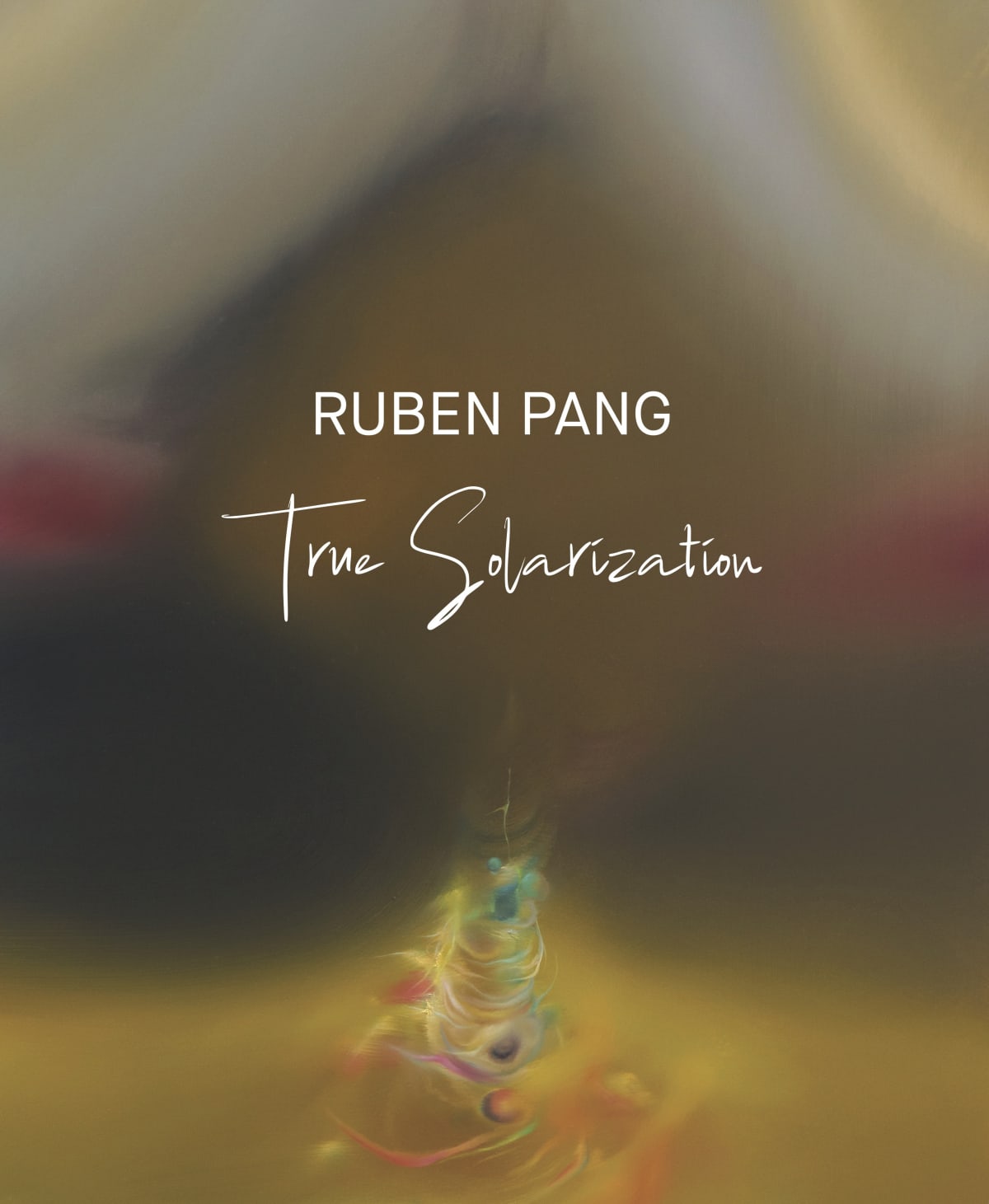True Solarization: Ruben Pang
Primo Marella Gallery is pleased to announce “True solarization” Ruben Pang’ third solo exhibition at the gallery in Milan.
CLICK HERE FOR THE VIRTUAL TOUR
TRUE SOLARIZATION
"We do not know where the great light was born, whether from the outside or from the inside, and when it has disappeared, we say: it was interior, yet it was not interior.
There is no need to ask where it appeared, because there is no point of origin here; it does not start from one place to go to another but appears and does not appear. Therefore, we must not chase it, but wait quietly until it reveals itself, as the eye waits for the sun to rise, which rises to the horizon and offers itself to our eyes to be contemplated. "
Plotinus, Enneade V 5,8 (On Beauty)
Sigmund Freud defines artistic talent as flexibility of removal because according to his thesis the unconscious is more easily accessible for the artist and therefore can proceed in this dimension between the conscious and the unconscious to intercept his artistic intuitions. The creative act becomes a pendular movement between conscious and unconscious impulses, while serving as a gradual process of raising one’s consciousness.
Everything is based on the idea of a creative chaos as the true origin of artistic creation. Pang's works are often containers of this chaos where we find an entropic force, the fundamental law of nature on which the ecosystem and therefore life depends. Entropy was used by Rudolph Clausius in 1850, in the second law of thermodynamics, to indicate the correlation between physical state transition and energy production.
“What is counterintuitive about painting, is that you are choosing to suspend movement, to arrest chaos, to defy gravity, to levitate. When you lift a brush away from a painting, where you decide to stop blending, when you decide to leave passages to dry, is where the attention and focus needs to be, even more so than the application, gesture, or movement. Paint being moved around, for me, is experienced through the skin and muscles, but choosing when to stop, is done with the eyes and a conversation with the heart.”
Clausius verified that at each change of state, with the consequent production or dispersion of energy, there is an increasing disorder in the structure of matter. According to this theory, the same word entropy was then applied in other fields, from mathematical theory of probability to information theory, psycholinguistics, and quantum physics.
The writer Thomas Pynchon gives us his definition of entropic disorder correlated with communication, coming to theorize a progressive loss of meaning of words because it is emptied of substance by excessively focusing on concept. It can reasonably be said art potentially loses its own sense if it progressively overworked and emptied.
In this land between chaos and potential opportunities, Pang creates his own universe and reminds us: “You can create a world, but you can't shape everything.”
The communicative emotion that he transmits to us through his paintings reflect the structures of language in unlikely associations. Similarly, we use slang/expressions in everyday communication that oppose grammatical rules, within painting, elements of disorder lubricate the transition from information into messages. Pang approaches his painting, specifically in his relationship with color, assigning them personalities and associations on top of their technical qualities, with whimsically misaligned elements to strengthen a reception of potential passages the composition can embark on.
“I tend not to think of colors in terms of their harmony or combinations that are known to create a certain effect. My experience of color is that each tint, shade, tone, and hue have a personal antecedent. In End of School for instance, I thought of flooding the atmosphere with the colors that correspond to the scent, packaging and scenes associated with a menthol cigarette: the 1990s, nostalgia, benign teenage delinquency. It was meant to simulate the “haze” of looking back in time. Every color is a memory, an aspiration, an attitude. And I prefer to think of the forms and colors of a painting as a collection of attitudes.”
According to the well-known art critic Greenberg, theorist of American modernism, the form of a work of art would be the state in which it leaves the norms and conventions of the artistic medium. For Greenberg, the artist seems to work against the resistance of his own medium and under his pressure and it is therefore assumed that, consciously, he dominates its conventions.
The artist produces images, forms, narrations but starting from the deconstruction of his experience, of his past, of what disturbs him, of outdated tragedies and hidden fears, casting the shadow of a memory that seems to come from nowhere.
“Showing up and being honest with yourself leads to a dialogue between previous scenarios in a painting—it is a dialogue between your experience with the material, the flux and volatility of oils and pigments, and the desire to have the fruits of opposing ideals; to keep the happy accident while realizing a vision, to be direct in intention, yet moved and deceived by illusions, to find a limit, effortlessly.
The nature of the painting game is that as new things develop, other things yield. At times, I feel an “opening” in a developing picture, a magnetism towards something mysterious, refractory, or suspended. If I put aside my initial ambitions for the composition, I am convinced that the painting is painting itself.”
During this process of deconstruction and construction of his works, Pang does not set limits, and through a stream of consciousness, he creates layers of paint, modifies the pre-existing ones, and redefines their contours spontaneously.
Evidently, for Pang, the painting frame, its outline, is a limes, a border that separates two lands and the tangible sign (often identified with a stone) that defines what is inside and outside. Limiting is an act of definition, it is an act of border creation between lived reality and its representation, in a nutshell, it is the most archaic manifestation of individual control and of the creation of identity.
In this reading, control and identity therefore seem to correspond as if they were an obsessive response to the question: who are we?
“Do you hunt ideas down or seed them? Do you need to shape every form or allow things to develop without meddling? Is there space in the painting for anything other than yourself?”
We often have the impression that to better see the outside world and consequently our life, we must move away from everyday life, from reality.
According to Foucault, the hermeneutical approach towards a work of art is characterized by the search for what has not been said, for what is hidden from the evidence of the sign and which would constitute the ultimate truth of the work of art. Pang, on the other hand, promotes research that is based on the creative moment and analyzes its relationships: the relationship between the author and the work, the relationship between the author and the environment and the relationship between the author, the work and his time.
“We are fortunate now, to have immediate access to the expanse of art history, and in a sense, we are always time-traveling. I find it comforting that the lessons and contributions of artists who lived centuries apart, for instance, Bruegel, Rubens and David Reed, are intimately present and accessible simultaneously.”
“A question that painters are asked often is ‘How do you know when a painting is done?’. You recognize something that you’ve never seen before, not through its image, but by how far you are displaced internally—depersonalization is my compass.”
Depersonalization in this context refers to the detachment and letting go of the initial intentions or ambitions for the artwork, by oscillating his focus between a vision in his mind’s eye and the physical situation of paint’s volatility, recognizing that the nature of painting is unprecise in translating thought, but presents several opportunities for what he considers magic.
Relationship between artist and environment: “Skywriters and Prism are two paintings of the same dimensions made with similar materials but with a drastically different result. In Skywriters, I painted in a very small space, almost seated at a desk all the time—i wanted to give the effect as if it were painted by a gnome, as if the frame of 60 x 75 cm was further than the horizon. It was also the first painting done after moving from Singapore to Sardinia, and it was done as a kind of initiation, “breaking in” and trying to find my footing in a new space. Prism was realized as a counterpoint to larger paintings of 220 x 150 cm, in the context of a larger studio that I had set-up, over the months. To reinforce the contrasts in approach from other works, I only used a large brush throughout the process and refrained from delineating any shape or figures within a single movement. I approached it as if I were allergic to the marks that could give away a human touch or personality.”
Pang’s approach to artistic creation is like a stream of consciousness, something that the artist is unable to stem but which is composed on the substrate as a trace of his experience.
The generating intuition, the creative act, the personal content, the psychological and human implications are the basis of his artistic poetics: man is at the center of his universe; his system of relations between the single components of a work is always sought because this structuralism is indicative of the research that pervades his poetics. Structuralism is a methodology that has established itself since the early twentieth century in various sciences, based on the assumption that each object of study constitutes a structure, that is, it constitutes an organic and global whole whose elements have no autonomous functional value but assume it within distinctive relations of each element with respect to the others of the whole.
The structural interest that outlines the conformation of a work in compositions such as Familial Ties, Solace and Individuality and End of School, abandons geometric lines and constructions to open up to Classical planes and compositions. This material structuralism is also witnessed in Michelangelo's work, The Last Judgment. However, Pang moves towards the direction of the eighteenth-century painter Alessandro Magnasco, where there is a sign of ambiguity in his compositions and forms, giving us the impression of an animation that starts from within.
We find in many of Pang's works a dialectic of opposites, a dialectic understood within the pictorial corpus in the making, with the colors and stratifications of architecture that guides us in this sense of an absence-presence.
“In the painting world, I get to insist that flesh becomes sky, earth can be inhaled. In Prism, for instance, I would like to create a sense of pressurized atmosphere, flesh and soil form a throat or a door. In End of School, liquid walls encompass a glacial anthropomorphic tree seeded from fire and children. In Familial Ties and History of Defensive Gardens respectively, a head in the former and a torso in the latter, becomes a portal. In Choleric, and in Ionosphere, what is usually regarded as the background of a painting becomes the protagonist of the scene. Here the play in composition is informed by music—jazz drums. The emphasis on the upbeat in jazz is transposed into the composition of painting: let space be the start of the show, let absence be the fulcrum.”
In Pang’s paintings it may seem that there is an indetermination of the forms, but his language serves to delineate of the conflict of a lived experience. It appears external and superior forces act to outline his subjects in the flux of painterly events.
We see a parallelism in the film L'Eclisse by Antonioni, the story of an unlikely love between two protagonists who live in a world without moral or psychological determination, where everything is independent of individual will or any logic of cause and effect. This allegory is a critique of our society. Pang's paintings share a common denominator of being pervaded by a vital force engulfed by the reality that surrounds it, as if magical currents bind human subjects to the objects that surround them. It does so as a gesture of provocation, not an end in itself, but as a gesture of stimulation towards a new level of cognitive reasoning of reality, as found in the work of the Dada artists who altered the order and physical size of words.
As Whitehead states in Adventures of Ideas: “There is in every period a general form of the form of thought: and like the air we breathe that form is so translucent, so pervasive and so evidently necessary, that, with only an effort extreme we manage to become aware of it. "
Thus, Pang's vision reflects a combination of painterly traditions, remote cultural influences, scholastic attitude, and technical needs and is at the same time, the daughter of an era, of a general feeling that brings the viewer of the work, like a theatrical performance, towards "consciously growing self-suggestions".
Similarly, the repertoire of epic literature also aims to identify the viewer with the characters represented. Greek tragedy is based on the contrast between the character and the actions of the hero, between his moral greatness and his senseless, often self-destructive deeds. This contrast does not develop to a real conflict because the hero, an unconscious victim of his own fate, transgresses the divine order only when it is already in progress.
Pang in his narration causes the hero to stop a moment before his annihilation, before the spiritual mystical fire envelops him; as in Lunar Snow, which is the successor to End of School, where he crosses the boundaries of narration to head towards new horizons via simplification and emptying, a distillation of the chromatic chart to include only that which is necessary.
In a mannerist thought of the relationship between man and environment, Pang’s varying works are united (and dominated) by ambiguity—the ambiguity of human existence and the double nature of man.
Text by Lorenzo Belli
-

Ruben Pang
Familial Ties and Proximity Effect 2020
Oil, alkyd, acrylic and synthetic varnish on aluminum composite panel
-

Ruben Pang
Solace and Individuality 2020
-

Ruben Pang
Sheath of Flexors 2020-2021
Oil, alkyd and dammar varnish on aluminium composite panel
-

Ruben Pang
The End of School 2020
Oil, alkyd, acrylic and synthetic varnish on aluminum composite panel







